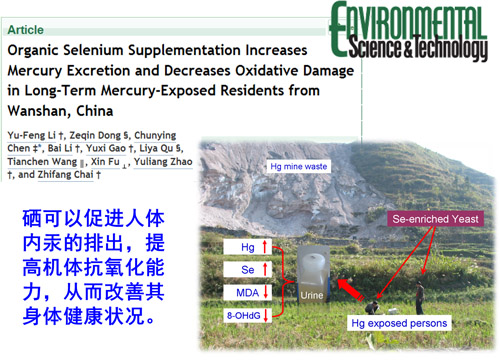Organic selenium improves health of the mercury-exposed
Scientists from Institute of High Energy Physics (IHEP) recently found that organic selenium supplementation could increase mercury excretion
 |
Selenium, one of the nutritious trace elements to human, has been found to antagonize the toxicity of mercury in animal studies. Increasing number of Se supplementation trials has been conducted in people suffering from HIV infection, Keshan disease, and arsenicosis, etc. Protective and beneficial effects of Se have been confirmed according to these studies.
To study the effect of selenium supplementation in long-term mercury-exposed population in Guizhou, IHEP scientists recruited 103 volunteers living in a local community near Wanshan mercury mine and gave them 100 micrograms of organic selenium daily for 3 months. Blood, urine and hair samples were collected to analyze the changes in these samples. This 3-month selenium supplementation trial indicated that organic selenium supplementation could increase mercury excretion and decrease urinary malondialdehyde and 8-hydroxy-2-deoxyguanosine levels.
The results from this study reveal that the small amount of Se supplementation (100 μg/day) can not only help the Hg excretion but also improve the antioxidant capabilities in local residents near the Hg mine area. Furthermore, considering the large amount of residents living around the Hg-related regions in China, this study may provide an easier and more practical way to restore and improve their health status.
Guizhou province is one of the largest Hg-mining areas in China. Due to the long history of Hg mining and smelting activities, the average atmospheric Hg concentration in this area is 2–4 orders of magnitude higher, compared to the values observed in pristine areas in Europe and North America. The health problems such as digestive dysfunction, hypomnesia, sleeping problems, and tremors have been found in occupationally-exposed persons. Therefore, it is urgently necessary to find ways to restore their health.
In China, other sectors related to mercury emission and usage includes non-ferrous metal smelting, coal combustion, cement production and PVC, fluorescent lights, thermometers production etc, if not well controlled, mercury released from these sectors may pose serious risks to human health.
As a well-known highly hazardous element, mercury (Hg) can induce toxic effects to central nervous system, kidneys, and lungs, and has been linked to a number of diseases like myocardial infarction, and even autism. The most well-known case of mercury poisoning is the Minamata disease that occurred in 1950-60s in Japan.
This experiment was supported by the National Natural Science Foundation of China, Youth Innovation Association, Chinese Academy of Sciences, Guizhou Academy of Environmental Science and Designing and some local government departments. The result has been published in Environmental Science and Technology (ES&T, 2012, 46, 11313-11318).
For further information, please click: http://pubs.acs.org/doi/abs/10.1021/es302241v